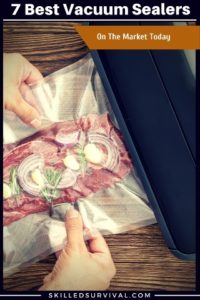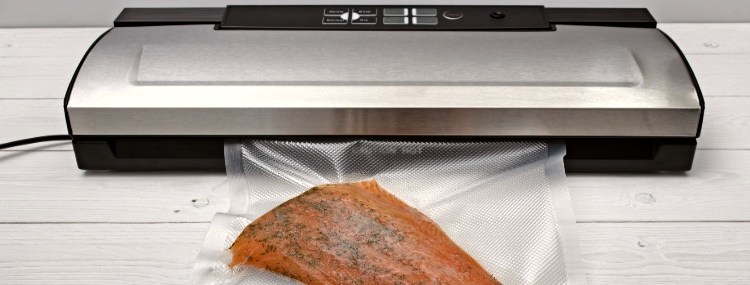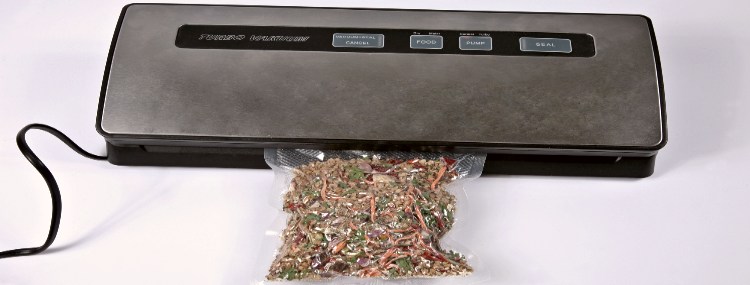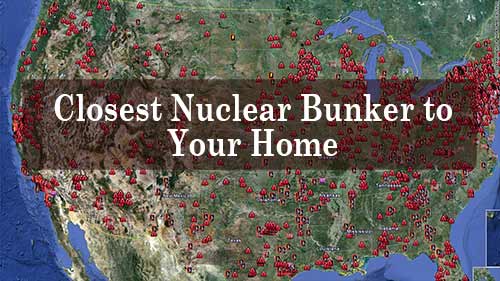
Why? Because there are so many brands and types of vacuum sealers, it quickly becomes overwhelming to sort through it all.
It’s easy to get so frustrated in the search for the right vacuum sealer, that you just give up.
But that’s a shame because vacuum sealers on one of the best kitchen appliances to own.
Not only is it a device that’s critical to keep your foods fresh longer, but it can save you a TON of money over time.
So today, I’m going to share everything I know about vacuum sealers, from how they work to their best features.
I’ll start off by share my favorite brands and units available today. Here’s a full list of ALL the vacuum sealer topics I’ll be covering:
- 7 Best Vacuum Sealers On The Market Today
- What Is A Vacuum Sealer Anyway
- Why Everyone Should Own A Vacuum Sealer
- Best Vacuum Sealer Features
- How Long Does Vacuum Sealed Food Last
- Best Vacuum Seal Bag Options (convenience vs. expense)
- How To Vacuum Seal All Sorts Of Food Items
- Items You Should Already Be Vacuum Sealing
As A Way To Introduce You To Skilled Survival, We’re Giving Away Our Family First Food Planning Guide. Click Here To Get Your FREE Copy Of It.
Best Vacuum Sealers To Stockpile & Save Money
FoodSaver Vacuum Sealer Machine with Automatic Bag Detection
The FoodSaver V4800 has automatic bag detection. Put the bag in the vacuum chamber, and the machine does the rest to keep your food fresh and flavorful.
Its built-in rolled storage and cutter lets you make custom-sized bags. While LED light indicators easily guide you through the vacuum sealing process.
Plus, its smart technology automatically detects moisture. So it will switch to the correct mode to ensure the proper airtight seal is achieved.
The patented drip tray that can be quickly taken out will catch any overflow liquid. This feature makes this kitchen appliance easy to clean and maintain.
The biggest downsides to this unit are it’s expensive and a bit bulky for permanent counter storage.
Vacuum Sealer Machine By Mueller
A Mueller Vacuum sealer preserves by blocking the growth of mold, fungus, and bacteria.
These are the things responsible for ruining food’s taste, appearance, and texture. And they can even cause acute illness as well.
The Mueller is made from durable ABS and features a high-powered suction element. And the heat sealing allows you to store your food in sturdy airtight bags.
Its stain-resistant housing will not absorb spills, and it’s straightforward to clean.
Also, you can use it to reseal wine, oil, or vinegar. You can also use it to preserve jewelry to keep it shiny and polished.
The one big complaint with this unit is the downtime required between sealing. This unit required a 40 second downtime between vacuum sealing. This limitation can slowdown your operations especially if you have a large batch of food to seal.
NutriChef PKVS Sealer
The NutriChef offers a fully automatic simple electric plugin design. With a control center placed on the top panel and a soft touch digital button along with an LED indicator light.
Also, it comes with a one-touch operation that allows you to select if you’re sealing a dry or moist food. The reusable and waterproof NutriChef bags protect the flavor, aroma, and texture.
Moreover, the auto one-touch operation delivers a user-friendly experience.
Plus, this vacuum sealer is both lightweight AND compact.
My two biggest gripes with this vaccum sealers are:
- You lose a good inch of bag every time you seal / cut. This means over time, you end up paying for more bags…
- Customer service is not responsive for some…
FoodSaver Vacuum Sealer Machine
The FoodSaver FM2000 keeps food fresh up to 5X longer compared to other storage methods.
It comes with an innovative removal drip tray to make cleanup fast and easy.
It features easy-to-use manual operations to preserve a variety of foods.
Plus, it comes with an accessory hose, making it compatible with FoodSaver boxes.
For all the good ideas with this unit, it does have a couple of drawbacks, namely:
- The lid is so thick it leave a ton of space between the food and the seal. So you end up with the same amount of waste as other models, just on the other side of the seal.
- It’s very loud during the sealing process
GERYON Vacuum Sealer Machine
The Geryon Sealer removes air from specially designed bags. And its multilayer material heat seals to keep air out and prevent freezer burn. It reduces spoilage and food waste.
You can take off the upper lid to clean the sealer quickly and safely. Also, it fits up to 12-inch widths. Plus, it’s designed with full auto seal operation. And includes soft-touch buttons and LED indicator lights.
It comes with two modes to ensure your food has the best possible preservation.
Of course the biggest RISK with buying this unit is the quality control. Some folks have ended up with a lemon from day 1. And some units seem to burn out after only a short time of usage.
It’s cheaper vacuum sealers but that reduction in cost seems to come with some risk.
As A Way To Introduce You To Skilled Survival, We’re Giving Away Our #78 Item Complete Prepper Checklist. Click Here To Get Your FREE Copy Of It.
What Is A Vaccum Sealer Anyway
Vacuum sealers work exactly how they sound. They vacuum the air out of a bag and then seal it.
This air removal process helps to compress and preserve the items stored inside the bag.
As A Way To Introduce You To Skilled Survival, We’re Giving Away Our Family First Food Planning Guide. Click Here To Get Your FREE Copy Of It.
Why Everyone Should Own A Vaccum Sealer
Investment / Save Money
My favorite prepping purchases are ones that pay for themselves.
Did you know the average US household wastes an estimated 76 billion pounds of food per year! That’s an average waste per person of 238 pounds per year (21 percent of the food purchased), costing about $1,800 per year.
Most of the food waste comes from fresh fruits (19%), vegetables (22%), dairy (20%), meat (21%), and seafood (31%).
All while there’s horrific starvation going on throughout the world – it’s so sad.
One way to reduce this problem is by using a vacuum sealer.
These devices allow you to preserve your food BEFORE it goes bad; BEFORE it turns into waste.
If you use a vacuum sealer, you can avoid this preventable waste AND save thousands of dollars per year!
That’s a win-win.
Saving money and saving the world.
Preparedness
Another reason to own a vacuum sealer is that it’s one of the most affordable ways to preserve food.
And I’ve written extensively about food storage and preservation techniques, such as:
- Best Home Freeze Dryers
- Best Food Dehydrators
- Top Survival Food Kits
- Best Non-Perishable Foods
- How To Make Pemmican
- How To Make Hardtack
- Mylar Bags – Food Storage’s Secret Weapon
- Canned Food Expiration Date Myth
Now, without a doubt, using a freeze dryer is the BEST way to stockpile food. Why? Because freeze-dried foods easily last decades!
How? Freeze dryers use extremely low temps and a vacuum chamber to remove ALL water content. And it does this without sacrificing texture, flavor, or nutrition.
But, there’s one massive drawback to Freeze Dryers – they’re expensive as hell. We’re talking over $2k expensive (for the small models)!
So the upfront cost to buy a freeze dryer is cost-prohibitive for most folks – myself included.
But you can pick up a vacuum sealer, with all the bells and whistles, for under $200.
And while freeze dryers remove moisture to preserve it, vacuum sealers remove oxygen.
And bacteria (the stuff that spoils food) is organic. So it needs what all living organisms need to survive (air and water). So by removing either of these elements, you stop food spoilage in its tracks.
Vacuuming sealing, and properly storing food, can provide shelf-stable foods for years. And sometimes even decades!
That’s what preparedness is all about, accumulating healthy foods for an uncertain future.
Vacuum sealers are an essential tool to build a food stockpile properly.
Waterproofing
Most people buy vacuum sealers to preserve food, but that’s not the only thing you can vacuum seal.
There’s a lot of gear, clothes, etc. that you also might consider vacuum sealing.
For example, you could vacuum seal some matches for your bug out bag. Or you could vacuum seal ammo before you put them into a survival cache.
Any gear to put into a plastic bag and vacuum seal immediately protects that item from water – genius!
Storage Compression / Saving Space / Organization
Vacuum sealers can crush fabrics or jackets down significantly in size. This process will keep your cramped closets organized and tidy.
For example, my wife owns several down vests, and those compress down to a fraction of the original size. These lightweight jackets are an ideal item to compress when not in use.
As A Way To Introduce You To Skilled Survival, We’re Giving Away Our #78 Item Complete Prepper Checklist. Click Here To Get Your FREE Copy Of It.
Best Vacuum Sealer Features
Automatic Bag Detection
Automatic bag detection makes vacuum sealing easier than ever. It allows you to add the tip of a bag to the mouth of the vacuum sealer, and the machine does the rest.
Auto means there are no levels to push or pull or activation buttons to push. Just feed the bag into the mouth of the machine, and it will detect it and begin sucking.
Accessory Hose
A hose attachment allows you to vacuum seal more than just plastic bags. You can use specialty attachments to vacuum mason jars as well.
This feature helps make your vacuum sealer much more versatile.
Here’s an example of an accessory hose put to good use:
Bag Storage Built-In
Another nice feature is a built-in bag storage location for a roll of specialty plastic bags.
Machines with this storage feature also tend to provide a slide cutter. So you can just pull the plastic out to any size you choose and cut it.
This feature is not only more convenient but helps eliminate waste. It does this by allowing you to custom-size the bags only to use the amount of plastic you need. No more, no less.
Removable Drip Tray
Vacuum sealing liquids can sometimes get messy. Spills and drips are inevitable. So most vacuum sealers include drip trays to collect this moisture to prevent spills.
But you want to make sure you get one with a REMOVABLE drip tray. This feature allows you to easily clean the tray out without having to put the entire unit in the sink.
“Seal Only” Button
Sometimes you just want to heat seal a bag WITHOUT sucking. This feature comes in handy when you are creating your own custom-sized bags.
When you pull a length of plastic off a roll and cut it, both ends will now be open. Before you can suck, you need to seal one of the bag ends first. But you don’t want to suck yet.
So you need a “seal only feature” if you want to use a bulk roll of plastic bags (instead of pre-bought ones).
And the bulk rolls save you money and reduce waste.
As A Way To Introduce You To Skilled Survival, We’re Giving Away Our #78 Item Complete Prepper Checklist. Click Here To Get Your FREE Copy Of It.
How Long Does Vacuum Sealed Food Last
Well, it depends on the type of food you’re trying to store, how that food is prepared, and what kind of bag you use to store it in.
But if you’re storing dry goods in Mylar bags and using oxygen absorbers. Plus, you keep these sealed bags of food in a cool dry location, you can start thinking in terms of decades!
Awesome, but what about foods with moisture?
Well, if you do a good job of dehydrating fruits and vegetables first, then you can see impressive results.
Again, if you remove moisture and air (oxygen), then mold, fungus, and bacteria cannot take root. IF those spoilers are blocked, the food will keep a very long time.
As A Way To Introduce You To Skilled Survival, We’re Giving Away Our Ultimate Survival Gear Checklist. Click Here To Get Your FREE Copy Of It.
Best Vacuum Sealer Bag Options (convenience vs. expense)
Most vacuum sealers come with their own set of vacuum seal bags. And choosing the right type of bag is essential for success.
Due to the way vacuuming sealing works, you need micro gaps in the bag.
If you look close, you’ll notice small bumps on the food storage bags made for vacuum sealing. These bumps are essential to the vacuum sealing process.
The bumps create small channels for the air to be removed from the bag. And if there are no bumps, theirs no airway to suck the air through.
This blockage is what happens when you try to use a regular bag (one without bumps) with a vacuum sealer. It doesn’t work!
There are three types of bags people tend to use with a vacuum sealer
- Vacuum Sealer Bags
- Mylar Bags
- Ziplock Bags
Vacuum Sealer Bags
These bags are the ones made explicitly for vacuum sealers. They have small bumps on the bag, but these bumps are not there for looks. The nodes allow air to suck through even when the bag is being held together by the vacuum sealer.
If these bags did not have bumps, then it would be more challenging to get any suction to happen. Why? Because if the plastic was smooth and flat, air couldn’t pass through to create the suction action.
Then once the air is removed, the vacuum sealer uses a heating element to melt the plastic, creating a seal.
These are the best bags to use for everyday use. But these bags are not ideal if your goal is extreme long-term storage; for that, you should choose Mylar bags.
Mylar Bags
Mylar bags are non-porous and remain completely sealed for years, and perhaps decades.
But because it’s so smooth, it’s impossible to draw air out of a Mylar bag using a vacuum sealer.
To make these bags work, you must add a small strip of specialty plastic to create a channel for the air to suck through.
Here’s a video showing this cost-effective and straightforward method in action:
Ziplock Bags
Everyone knows Ziplock bags, and they do make a “ziplock” version of the plastic vacuum seal bags. And the reason we all love ziplock bags is because of their extreme convenience.
But, standard zip locks are not made to work with vacuum sealers. And the specialty ones are cost-prohibitive.
So, if you’re interested, there is a way to use regular zip locks with your vacuum sealer. Yes, it does take more steps, but it’s not too bad if you’re interested in saving a few dollars.
As A Way To Introduce You To Skilled Survival, We’re Giving Away Our #78 Item Complete Prepper Checklist. Click Here To Get Your FREE Copy Of It.
How To Vacuum Seal All Sorts Of Foods
Man! There’s a TON of excellent resources available on the web on “how-to” vacuum seal “just-about-anything”. I’ve spent hours founding the best videos and I’m going to share them all next.
Note: You may want to consider bookmarking this page, so you can quickly return when you’re ready to start using your vacuum sealer in the future.
How To Vacuum Seal Meat
Many people purchase a vacuum sealer to store bulk meat in their freezer. This makes sense because if you do it right, you’ll eliminate freezer burn and the meat will taste fresher when you’re ready to eat it.
How To Vacuum Seal Avocados
I don’t know how many avocados I’ve lost over the years. These suckers will go bad in just a couple of days, which means it’s risky to buy in bulk. But not if you vacuum seal them!
How To Vacuum Seal Your Favorite Fish And Wild Game
This video shows you how to prep and season your wild game for vacuum sealing:
How To Vacuum Seal Soup
Soups are tricky to vacuum seal but not impossible. Check out this video to learn how:
How To Vacuum Seal Bread and Hamburger Buns
Sealing bread (especially soft pieces of bread like buns) can be a challenge IF you don’t know what you’re doing. Most people end up with squished bread that’s flat as a pancake. Not good.
So instead, watch the video below to see how easy it can be once you learn the correct way:
How To Vacuum Seal Moist Foods
Vacuuming sealing moist foods can be extremely messy. That’s why most vacuum sealers come with drip trays. But if you get the right bags, you can nearly eliminate this headache altogether!
How To Vacuum Seal Flour For Long Term Storage
Does Vacuum Sealing Speed Up Marinating?
YES, SIGNIFICANTLY! Negative air pressure helps to pull a liquid marinade into the meat.
As A Way To Introduce You To Skilled Survival, We’re Giving Away Our Family First Food Planning Guide. Click Here To Get Your FREE Copy Of It.
Items You Should Already Be Vacuum Sealing
Check out this excellent video from Canadian Prepper if you’d rather watch than read this list:
1. Food
Meats, Veggies, Fruits, Snacks, You Name it, You Can Probably Vacuum Seal IT!
2. Water
I store water in Legacy Premium 5 Gallon Stackable Containers. Some people buy canned water instead.
Another alternative to expensive canned water is to vacuum seal your own water in Mylar bags.
You can filter water before vacuum sealing and store it in a safe location. It’ll remain safe and delicious until the day you need to crack a pouch open to survive.
3. Toilet Paper, Towel, Wipes
With the COVID-19 pandemic, everyone now realizes how critical TP is for everyday life. That’s why many people have stocked up to prevent being caught off guard in the future. Great!
But here’s the problem, what if your TP stash gets wet from a flood or a pipe leak? It could ruin your entire investment. Plus, stockpiling TP takes up a ton of storage space.
So to fix both of these issues, you could vacuum seal your TP and compress it (to save space) AND make it waterproof! This strategy makes sense to me.
Note: Any type of thin fabric or cloth will compress down to a much smaller size when most of the air is removed.
4. Batteries
You should waterproof your batteries. This is especially true IF you pack batteries in your survival pack or bug out bag.
Vacuum sealing keeps them safe and helps to prolong their shelf life.
5. Fire Starting Kit
There’s nothing more demoralizing than showing up at your campsite and can’t make a fire.
This is your fate if your survival lighter or survival matches become soaked. They become useless.
No spark, no fire, no heat, no cooking…bummer
So put your matches and lighters in a plastic bag and vacuum seal them to make them waterproof.
6. Ammunition
Listen, if you’re into preparedness, then you know how important it is to store your ammo the right way.
And usually, I’d suggest using ammo cans with good seals (plus using oxygen absorbers).
But what if you want to bury some ammo in a survival cache?
Well, in this case, I suggest you vacuum seal your ammo to prevent any moisture-based corrosion.
7. Medication
If you want your medications to last many years, get them out of those pill bottles.
Instead, use Mylar bags to seal those critical meds for the long haul.
8. First Aid Kits
Small first aid kits are generally not waterproof. But these are also the kits that are best for your survival pack, bug out bag, or get home bags.
But downpours or river crossings can put all your gear into jeopardy. So waterproof that bad boy using plastic bags and vacuum sealing.
9. Sharpie Markers / Pens
Ink will eventually dry out when exposed to air.
So vacuum seal a few, and you’ll know you’ve got the power of the pen no matter what the future holds.
10. Spices
Spices can lose flavor over time. They won’t typically “spoil” but what good is a spice that has little or no flavor.
But you can save that flavor profile longer by trapping them in an airtight vacuum chamber.
10. Hand Crank Radio
If you use Mylar bags for storage, you’re creating a mini Faraday bag.
An EMP electrical pulse will go around the foil of Mylar and protect the devices within. So add a hand-crank radio (or any electronic devices) to a Mylar bag and vacuum seal it.
12. Firearm
Again, survival caches are known to be exposed to moisture – no matter how well you seal the container.
And if you store ammo in your survival cache, you may also want to have a firearm to go with said ammo.
So suck out the air and wrap it up!
13. Seeds
Seeds are powerful, especially in a doomsday scenario. A seed can equal an abundance of food and nutrition.
They have extreme value in a barter economy.
That’s why you should protect that value by sealing them up. Don’t let them go bad prematurely.
14. Documents / Photos
You can vacuum seal your documents or laminate them. Both of these techniques protect critical documents from water damage.
So if you’re worried about flooding– consider vacuum sealing your critical docs.
15. Socks/Underwear/Tee-shirts
You should take at least one change of undergarments in your bug out bag. And I like to put them in a skivvy roll to keep them organized and compact.
However, you can compress these “small clothes” even more. AND make them waterproof by vacuum sealing them.
Final Thoughts
A vacuum sealer is a wise investment, especially if you’re into preparedness.
Because when you store foods without moisture or air, they last much much longer. This method helps to prevent unnecessary food waste and builds valuable food stockpiles.
Save money AND become more resilient? A vacuum sealer is truly a “no brainer” investment.
“Just In Case” Jack
P.s. Do you know where the closest nuclear bunker is from your home?
There are a lot of natural nuclear shelters in the US that are absolutely free. And one of them is near your home.
Click here to see the Closest Natural Nuclear Bunker to Your Home?
Click on the image above to find out where you need to take shelter.
The post Best Vacuum Sealers To Build Your Stockpile & Save Money appeared first on Skilled Survival.










